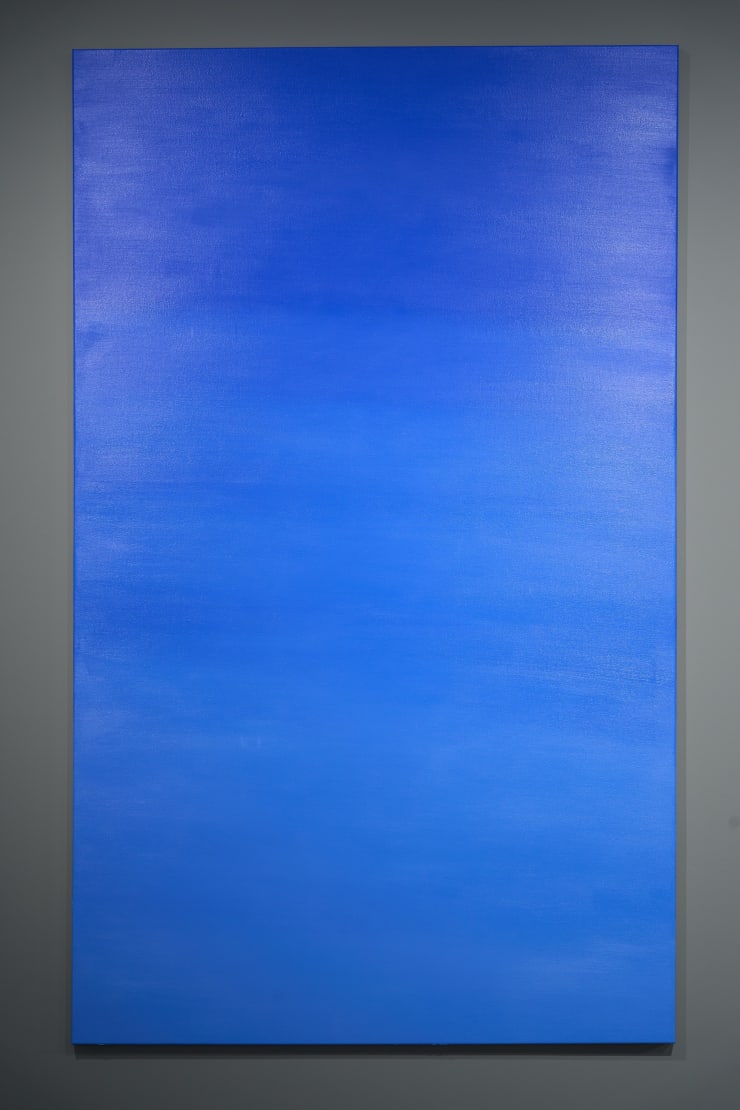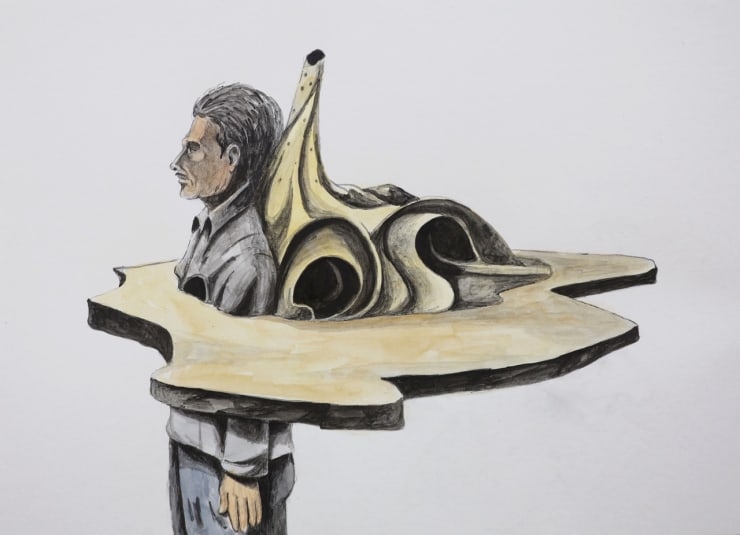-

-

-
Traversing the macrocosm through one’s body as a way of seeing and experiencing, Radhika Khimji draws on an array of mediums and a layered technique of mark- making to reimagine geographies and abstract aspects of the environment. Khimji’s visual language searches for a place between architecture and gesture through a collaged way of working. Informed by the physicality and materiality of the making process, Khimji’s work navigates the perpetual displacements of the transitory and fluid body moving across a space fragmented by many polarities.
-
Rooted in process and the act of making, Ayesha Sultana’s practice is an ongoing investigation of drawing, of seeing space in continuum, of exploring gaps in visual memory and of looking at the periphery and what is overlooked in plain sight. Sultana’s paintings depict an infinite landscape of space between empty sky and sea where vistas in the foregrounded paintings meet colour-fields, and light gives way to vacuity. In the Miasms series, the artist explores ephemerality and fluidity. Tissue paper with its delicate and translucent nature is easily torn, damaged, dissolved, and dispersed. However, it transforms from a tenuous medium into a vehicle for artistic expression evoking both skin and the turbulence of the sea.
-
Christopher Kulendran Thomas’ paintings metabolise Sri Lanka’s colonial history, compressing mutliple art historical timelines onto a single canvas. He is an artist of Tamil descent, who spent his formative years in London, after his family left Sri Lanka during the escalating ethnic oppression there. Through immersive film installation, painting and sculpture, Kulendran Thomas’ practice explores lost histories, alternative possibilities and Sri Lanka’s colonial art history. He uses advanced technologies across multiple disciplines and often through fluid collaborations with architects, writers, technologists, designers, musicians and activists from around the world.
-

-
-
 Rathin Barman, Space Counts 60, 2025
Rathin Barman, Space Counts 60, 2025 -
 Rathin Barman, Space Counts 61, 2025
Rathin Barman, Space Counts 61, 2025 -
 Rathin Barman, Space Counts 62, 2025
Rathin Barman, Space Counts 62, 2025 -
 Rathin Barman, Space Counts 63, 2025
Rathin Barman, Space Counts 63, 2025 -
 Rathin Barman, Space Counts 65, 2025
Rathin Barman, Space Counts 65, 2025 -
 Rathin Barman, Space Counts 67, 2025
Rathin Barman, Space Counts 67, 2025 -
 Rathin Barman, Space Counts 68, 2025
Rathin Barman, Space Counts 68, 2025 -
 Rathin Barman, Space Counts 69, 2025
Rathin Barman, Space Counts 69, 2025 -
 Rathin Barman, Space Counts 70, 2025
Rathin Barman, Space Counts 70, 2025
-
-
Rathin Barman (b. 1981; Lives and works in Kolkata, India) draws attention to how architecture adapts itself to a growing influx of people over extended periods of time through the Space Counts series. By providing an anthropological lens into the endless possibilities a space can entail, Barman redefines the idea of architecture as a fixed entity through multiple charcoal or pigment dissections and brass inlay on a concrete base, to reflect on human interventions upon built environments. Translating the aesthetic idea of a space or an illusion of a space with functional aspects, the series highlights Barman’s gaze at details of buildings and the multiplicities of their architectural intricacies, such as windows, trellises and grilles. Like trees with shared roots, these homes are polycentric, since most of these structures are interlocked and inseparable and so are its people and their personal histories and relationships with each other.
-
Julien Segard carefully considers the urban environment, the crevices where the constructed meets the natural, and how the two become inseparable. His works feature an assemblage of found elements and architectural structures that exist because of humans, but are bereft of human presence. The intimate, symbiotic, and oftentimes destructive relationship between man, nature and architecture become points of introspection for Segard in his works. Rooted in experiences of solitude and silence, Segard’s practice immerses the viewer in the minuteness of their elements while simultaneously operating as the entry points into vast infinite spaces.
-

-
Sakshi Gupta’s work explores visual and tactile contradictions and complexities through sculptural reinterpretation of everyday objects. She challenges the boundaries between art and life by juxtaposing materials in unexpected ways, re-evaluating how we perceive what is typically overlooked or considered obsolete. Central to her practice, are found materials that contain their own histories, unraveling notions of transience, resilience and permanence.In the works presented, the soft, familiar forms of a plush toy are given a hard metal scrap skin. Through its tactile quality, the works play with a sense of deception where initial expectations of malleability are quickly diminished by the solid, weighted nature of the object. The nondescript toy becomes a means to reflect on transient emotional junctures, loss of innocence, reckonings with disillusionment and abdications of facades.
-
Prabhakar Pachpute’s series of works on paper are reflections of his road trip to northern India and Nepal in 2023. Pachpute visited Bhimbetka, the Sanchi Stupa, Khajuraho, Nalanda, Kushinagar, Sarnath, Lumbini, and Kapilvastu in Nepal, following the traces of Buddha and archaeological sites and shifting rural landscape drastically into industrialisation. During the trip, he observed and documented the symbols on stupas, relics, design of animal prints, architectures and its interpretation.Some of the works from this series resonates with my previous ideas of ‘act of unearthing’, which discovers not just the physical remnants but also the emotional and aesthetic layers embedded within. Through excavation both literal and metaphorical, the works reflect how our memories and interpretations shift across time as we know the facts.Pachpute often creates immersive and dramatic environments in his site-specific works, using portraiture and landscape with surrealist tropes to critically tackle issues of mining labour and the effects of mining on the natural and human landscape. Using Maharashtra as a starting point, the artist combines research from around the world and personal experiences, moving from the personal to the global investigating a complexity of historical transformations on an economic, societal and environmental level.
-

-
Praneet Soi presents a selection of works from the series Colour Tests, made originally for an exhibition at the Van Loon Museum in Amsterdam, Netherlands. Inspired by the ‘grisailles’ painted on wooden cabinets in the museum’s hallway, Soi incorporated shades of grey used within this trope as a starting point into an exploration of colour within this recent body of work created in his ongoing immersion with craftsmen in Kashmir. The craft of painting on papier-mache, introduced to Srinagar by Sufi preachers traveling to Kashmir from Central Asia in medieval times, captivated Soi to work with the master craftsman Fayaz Jan in the traditional Karkhana, or studio to produce hand-made papier-mache tiles and painting upon them traditional Kashmiri motifs. Ever since his first immersion with the craftsmen in 2014, Soi has been returning to Srinagar to intertwine himself within the Karkhana’s working rhythm, making decisions with the craftsmen pertaining to the motifs, such as their color and composition, that are historically recognizable within the region’s craft industry, but which push away from their original decorative trajectory into what might be described as experimental compositions. Soi often-times introduces his own imagery into the conversation, opening up interesting possibilities to explore with craftsmen. These are hybrid constructions, containing within them not only conversations between Soi and the craftsmen but also the histories of patterns as they migrated across geography and culture in times gone by.
-

-

-
-
 Vikrant Bhise, Web of displacement, migration and subsistence (I), 2025
Vikrant Bhise, Web of displacement, migration and subsistence (I), 2025 -
 Vikrant Bhise, Web of displacement, migration and subsistence (III), 2025
Vikrant Bhise, Web of displacement, migration and subsistence (III), 2025 -
 Vikrant Bhise, Disruptions and destructions (I), 2025
Vikrant Bhise, Disruptions and destructions (I), 2025 -
 Vikrant Bhise, Disruptions and destructions (III), 2025
Vikrant Bhise, Disruptions and destructions (III), 2025 -
 Vikrant Bhise, Disruptions and destructions (V), 2025
Vikrant Bhise, Disruptions and destructions (V), 2025 -
 Vikrant Bhise, Disruptions and destructions (VI), 2025
Vikrant Bhise, Disruptions and destructions (VI), 2025 -
 Vikrant Bhise, Consciousness towards pillars of equality (I), 2024
Vikrant Bhise, Consciousness towards pillars of equality (I), 2024 -
 Vikrant Bhise, Consciousness towards pillars of equality (II), 2024
Vikrant Bhise, Consciousness towards pillars of equality (II), 2024 -
 Vikrant Bhise, Consciousness towards pillars of equality (III), 2024
Vikrant Bhise, Consciousness towards pillars of equality (III), 2024 -
 Vikrant Bhise, Consciousness towards pillars of equality (IV), 2024
Vikrant Bhise, Consciousness towards pillars of equality (IV), 2024 -
 Vikrant Bhise, Consciousness towards pillars of equality (V), 2024
Vikrant Bhise, Consciousness towards pillars of equality (V), 2024
-
-
Vikrant Bhise’s artistic practice iterates his commitment to the revolutionary spirit inherent in the Ambedkar consciousness, and struggles against caste-based domination and its vertiginous implications on land, liberty, and labour. Bhise’s iconography is informed and deliberate in its radicality as evident in his series “Consciousness towards pillars of equality”, “Disruptions and destructions”, and “Web of displacement migration and subsistence”. The dynamic narratives demur to violation of social justice, hoping to inspire reform through activism while remembering episodes of fundamental struggles that include but are not limited to caste, class, and gender-based oppression.
-

-
Adip Dutta’s (b. 1970; lives and works in Kolkata, India) practice is immersed in the nightscape of the city, relooking at the sculpturality of form left behind in empty spaces of bustling footpaths, wares sold on streets tightly packed with tarpaulin and discarded items of daily use – in an extension of his exploration of form, objecthood, materiality, but also as witnesses to his ethereal vision of the nightscape where the objects lie as mortal remains as well as desires for the vital and the regenerative. Dutta’s gaze invites the viewer to renew the value we assign as a society to objects that are every day and occupy our field of vision, and in which the city remains intrinsic to their being.
-

India Art Fair 2025
Current viewing_room

























































